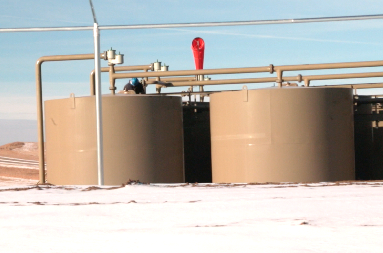Have you felt dizzy or lightheaded after going up on a tank battery?
You aren’t alone — lots of people who work around crude oil tanks have felt the same way. You may have been exposed to a high concentration of petroleum gases and vapors — things like benzene, butane and ethane. Not H2S.
Since 2010, at least nine oil workers have died after inhaling petroleum gases and vapors.
As a reporter with Inside Energy, a journalism collaborative which covers the energy industry in North Dakota, Wyoming and Colorado, I have been reporting on petroleum gas exposures among oilfield workers for the past few months. I’ve talked to doctors, government officials, safety trainers and lots of workers. Here’s what I have learned:
The Basics
– There are a lot of names for “petroleum gases:” sweet gas, flammable air, LELs, hydrocarbon gases and vapors, etc.
– Petroleum gases are different than hydrogen sulfide/H2S.
– Workers are exposed when they open the thief hatch on an oil or water tank, releasing gases and vapors that are under pressure.
– Workers who have inhaled petroleum gases report feeling drunk, dizzy or light-headed, but then these symptoms clear up when they get into fresh air.
– But workers can die after just a few minutes of breathing high concentrations of petroleum gases.
The 9 Workers Who Died
– Of the 9 workers who died, 5 were truck drivers
– Five of the 9 workers died while taking oil samples. The other 4 died while gauging the tank.
– They were all working alone when they died.
– They died in Colorado, North Dakota, Montana, Oklahoma and Texas.
– Their ages ranged from 20 to 63.
Why People Are Exposed
– On federal and tribal leases, strict federal regulations mean there are only two ways to get oil measurements: manually or with a LACT. Most companies choose manually.
– On private/state leases, states decide what methods are allowed. But most companies choose manual tank gauging because it is the cheapest method.
Where To Learn More
– Listen to and read our stories on deadly gas exposure in the oilfield.
– Read this guide on how to stay safe while working around crude oil storage tanks, put together by the same workplace safety researchers that first identified what had killed those nine workers.
– Read the scientific study describing how those nine workers died.
– This safety alert, put out by industry and government safety groups, is also worth checking out.
– Watch this video of workers being exposed to petroleum gases, taken with an infrared camera.
Talk To Us
We are looking to talk to more workers who have been exposed to petroleum gases. This is totally anonymous.
We’re especially interested in the following:
- Have you ended up in the hospital after having a really bad hydrocarbon gas exposure?
- Does your company require manual tank gauging? Does your company use any kind of automatic tank gauging?
- Has your company/the operator downplayed the risks of petroleum gas exposure?
- Have you worked somewhere where your company took petroleum gas exposure seriously and protected you from this hazard/gave you helpful training?
Contact Info
- Text “safety” to (701) 354-4414
- or email us at: eguerin@insideenergy.org








